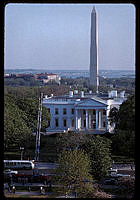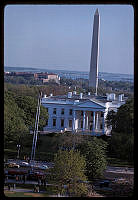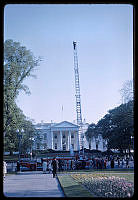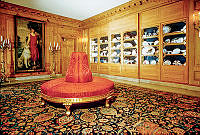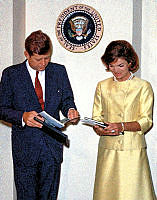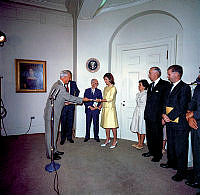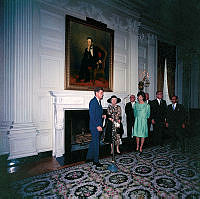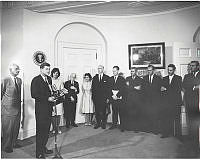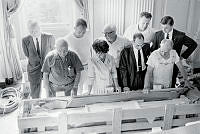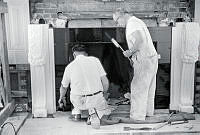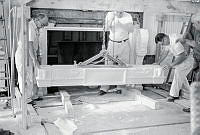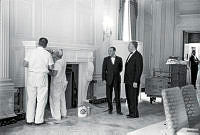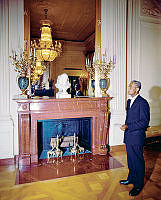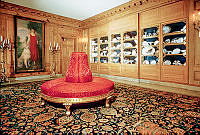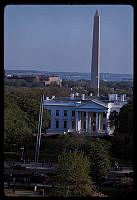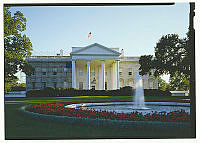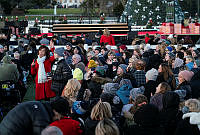A Special Space Lost and Found Images of Abraham Lincoln's White House Stables
Copyright © Summer 2011 White House Historical Association. All rights reserved under international copyright conventions. No part of this article may be reproduced or utilized in any form or by any means, electronic or mechanical, including photocopying, recording, or by any information storage and retrieval system, without permission in writing from the publisher. Requests for reprint permissions should be addressed to books@whha.org
The Smithsonian Institution in Washington, D.C., has often been referred to as “The Nation’s Attic” for its vast holdings of historic memorabilia. if that assessment is accurate, then the Photographic Division of the Library of Congress must be considered “The Nation’s Family Album.” With holdings of more than 10 million photographs and negatives, the Library of Congress clearly stands as the world’s largest single repository of photographic images. The breadth and diversity of the subjects represented in its collection are as impressive as the sheer mind-numbing numbers of pictures. Of course, the stupendous iconographic classics are present—an 1846 daguerreotype portrait of the 36-year-old representative from Illinois, Abraham Lincoln; the “Migrant Mother” by Dorothea Lange epitomizing the anguish of the Great Depression; the dramatic flag-raising on Mount Suribachi, Iwo Jima, snapped by Joe Rosenthal; Martin Luther King delivering his famous “I have a Dream” speech during the height of the civil rights movement; and Neil Armstrong extending his boot to make mankind’s first contact with the surface of the Moon.
There are even collections within collections, like the documentary photographs of the civil War by Mathew Brady, Alexander Gardner, and George Barnard. The exploration of the American West was stunningly photographed by Timothy O’Sullivan, W. H. Jackson, and John Hillers—their work all preserved at the Library of Congress. The transformation of America from a horse-drawn agrarian society to a motorized urban center was photographed by a legion of professional and amateur photographers whose collective work now presents a permanent record. With an influx of about 80,000 images per year, according to Carol Johnson, curator of photographs at the Library of Congress, it is not at all surprising that a small group of dim, seemingly faded photographs of public buildings in Washington, D.C., would elude the attention they most richly deserve. Purchased at auction in 1984, the early paper photographs were not evaluated until twenty-six years later when an astute researcher recognized their significance. Two of the architectural images hold particular historic interest as they are the only extant photographs of Abraham Lincoln’s White House stables, a building that played an important yet sad role for the wartime president.
In early summer 2010 the Photographic Division at the Library of Congress began an effort to increase its much-needed storage space in the Madison Building. The contents of archival boxes were revisited to determine if less important or seldom used materials could be moved to an off-site facility. It was during this exercise that Bret Carnell, team leader of Technical Services, uncovered a group of thirteen photographs of public buildings taken in Washington, D.C., before the advent of the Civil War.
The images are salt print photographs, the earliest of the paper processes, invented by Englishman Fox Talbot in 1839 and used by American photographers on a limited scale until 1860, when the albumen paper print became universally adopted. The salt print is characterized by its soft brown or sepia tonal range sometimes mistaken as a faded print. The earliest negatives used to make salt print photographs were on waxed paper, which produced images lacking clear definition. subsequent efforts showed that glass negatives provided greater clarity for the salt print photograph, and undoubtedly the images in the Library of Congress were made in this manner. Photographic historians at the Library of Congress concluded that the newly recognized group of salt print photographs were made between 1857 and 1858 and are the work of Lewis emory Walker (1825–1880)—this based on date, subject matter, and the size of the prints.
Walker, a native of Greenwich, Massachusetts, began his photographic career as a daguerreotypist and became an itinerant photographer. At age 33 in 1856, he took charge of Mathew Brady’s fashionable New York gallery. in June 1857, Walker accepted the position of chief photographer of the Treasury Department, where it was his job to document construction projects. he worked in that capacity for twenty-three years until his death in 1880. Some of Walker’s salt print photographs were published in the Photographic and Fine Art Journal, and several of his Washington, D.C., architectural photographs appeared as woodcut engravings in contemporary periodicals including Harper’s Weekly and Frank Leslie’s Illustrated Newspaper during the 1860s.1 A rare photographic portrait of Abraham Lincoln, published in 1865 by E. & H. T. Anthony as a stereoview, is attributed to Walker.2
Most of the recently discovered Walker salt print photographs are identified by captions penned in ink on the oversize paper mounts.3 There are two architectural views of the Treasury Building under construction, one dated March 3, 1858, and another of the state Department in 1857. Two views show the south side of the White House, one detailing the newly constructed conservatory on the west end. This is the earliest known photograph of the president’s greenhouse.4 There is also a cityscape with the Smithsonian Castle looming in the background and a fine view of the equestrian statue of Andrew Jackson rearing his horse skyward in Lafayette Park. Perhaps the most historically important of all the Walker salt prints are the two images identified as the “President’s stables.” A search of photographic archives in the White House, Library of Congress, National Archives, and other major holdings of historic images, both private and public, reveals that no other photograph of the Lincoln stables is known to exist.
Before the President’s House was constructed in Washington, D.C., George Washington and John Adams had personal stables for their carriages and horses associated with their residences in New York and Philadelphia. In 1800 the first White House stables were located on a square bounded by F and G and Thirteenth and Fourteenth streets.5 in the spring of that year a proposal was made to construct new stables for use by the White House, and bids were solicited for “building a brick stable to contain stalls for 12 horses, carriage house to contain three carriages, and a small room for Grain.”6 The building was completed on August 11, 1800, at a cost of $1,600 and was used by the White House until 1806, when President Thomas Jefferson added stables and cowshed to the east side of the Executive Mansion. A carriage house was constructed near the stables in 1809 and, explains Herbert R. Collins, “during the Madison Administration, Benjamin Henry Latrobe directed the building of new coachhouses as an addition to the existing stable.”7
After the partial destruction of the White House by the British in 1814, a stables and carriage facility was built, running as an ell southward from the rebuilt west wing. It was not until President Andrew Jackson’s second term in 1834 that, collins says, “the old frame stable at the end of the east wing was removed and a stable—to accommodate ten horses—was erected a hundred yards east of the old site.”8 The Jackson stables were built of brick and stone with stucco covering at a total cost of $3,507. The tall, wide building was sheltered behind a brick fence positioned in its own grassless yard. After twenty years of use, however, the Jackson stables stood squarely in the path of progress, more precisely the Treasury extension project. William Seale gives the details: “On February 2, 1857, the preliminary paperwork began with a note from the superintendent of the Treasury project to Secretary of the Interior, Robert Mcclelland: ‘sir, the time is near at hand when it will become necessary, in constructing the Treasury Extension, to take down the stable and Greenhouse now standing on the ground about the President’s House.’”9 The idea to construct new and expanded White House stables repositioned 200 yards to the south of the previous structure began with President Franklin Pierce, but actual construction of the buildings did not start until James Buchanan assumed office in 1857.
The new White House stables were erected under the direction of commissioner John B. Blake and the architect Edward Clark. Appropriations through the Department of Interior indicate that Commissioner Blake spent $23,905 from July 1857 to August 1858 for construction of the White House conservatory and stables and that the cost for the construction of the stables alone was $8,448.10 The new presidential stables were completed in July 1857. There is ample reason to believe that the L. E. Walker photographs of the building were made in the early spring of 1858, as evidenced by the leafless trees and the small mound of melting snow at the base of a wooden shaft positioned just to the left of the building shown in the photographs. This wooden shaft and the guidepost directly in front of it perhaps served as an anchor for an industrial cable used in the construction of the Treasury extension.
The newly discovered Walker salt print photographs showing the rear (east side) of the president’s stables provide a clear understanding of the construction and design of the building and its surround. Amazingly, when the two photographs of the stables are placed side by side, a slight overlapping of the images provides a continuous panoramic view of the backyard of the White house. The stables were a two-story brick structure with metal roof and a center octagonal cupola with louvered windows that ventilated the building. The cornice on the rear (east side) of the building exhibits thirty-nine ornamental brackets. The second floor has six windows with stone basket-handle arches and sills. each window contains twelve panes—six vertical rows with two panes across. The first floor has six narrow windows with stone arches corresponding to the upper level. A one-story extension at the far north end of the building has a wide, wood-framed arched entrance used to admit carriages. The flat porch roof with reoccurring ornamental brackets on its cornice is supported with five rectangular wood columns, each with a simple entablature, capital, base, and stone pedestal. The porch extends across the entire width of the structure. The upper story at the south end of the building has five stone basket-handle-arched windows—two narrow windows on either side of the taller and wider central win- dow. There are five wood-framed arched doorways for horse stalls on the ground level. According to one account the materials salvaged from the Jackson stables were reused in 1857 to help construct the new stables.11 Plans for the building called for stucco to cover the brickwork, although the 1858 Walker photographs indicate that the work was not done at that time.
The new White House stables served President James Buchanan during his tread-water administration, providing horses and carriages to fete the visiting Japanese ambassadors in the summer of 1860 and the Prince of Wales with his courtly entourage in the fall of that same year. During the tumultuous war years of Lincoln’s administration the stables provided housing for the presidential carriages and horses and doubled as menagerie for the diversity of pets owned by the Lincoln boys, including rabbits, two ponies, a pair of goats, and a turkey named Jack.
A suspicious fire engulfed the White House stables on the cold evening of February 10, 1864, reducing the building to charred rubble. About 8:30 p.m. smoke and flames were seen shooting skyward from the brick structure just east of the Executive Mansion. President Lincoln personally responded to the conflagration. According to an eyewitness report:
Just then the front door of the White House flew open with a jerk, and out came the President buttoning his coat around him, and said to me, “Where’s the fire, what’s burning?” I said, “It seems to be around in the vicinity of the stable.” With that he started off on a dog-trot down the steps and along the way leading to the stable. When he started to go to the fire, I thought to myself, “Old fellow, you are the man we are guarding, guess I’ll go along.” So i struck out on the double-quick and went with him, keeping close to his side; but he took such long strides that his dog-trot was almost a dead run for me. As soon as we got around where we could see what was burning, we saw that, sure enough, the White House stable was on fire. Quite a crowd had gathered by the time we got there, and the fire department was at work. Mr. Lincoln asked hastily if the horses had been taken out, and when told they had not, he rushed through the crowd and began to break open one of the large doors with his own hands; but the building was full of fire, and none of the horses could be saved.12
Two horses belonging to Abraham Lincoln and two others, the property of John Nicolay, the president’s private secretary, perished in the fire. it was the loss of the ponies, however, one of which had belonged to Willie Lincoln, the son who had died in 1862, that most afflicted the Lincoln family. According to another eyewitness, Francis Carpenter, “Lincoln and others were standing in the East Room looking at the still burning stables. Lincoln was weeping. Tad explained it was because Willie’s pony was there.”13 Tad was emotionally devastated over the death of his own pony. According to Carpenter, “Upon Tad’s learning of the loss, he threw himself at full length upon the floor, and could not be comforted.”14
On the day of the catastrophic destruction of the Lincoln stables, coachman Patterson McGee was dismissed from the White House staff. Later he was seen at the site of the fire. The following day, Thursday, February 11, McGee was arrested and charged with setting the stables ablaze. Although there was ample reason to suspect McGee of the arson, he was subsequently released for lack of evidence.15 On the same day of McGee’s arrest, Lincoln met with Benjamin Brown French, commissioner of public buildings, concerning the rebuilding of the White House stables, and a few days later Congress appropriated $12,000 to replace the structure.
One interesting sidelight to the loss of the White House stables concerned the liability of the government to replace greenbacks that were consumed in the fire, property of one of the coachmen living in the stable. Robert Lincoln, then a 21-year-old Harvard Law School student, approached his father with a legal issue, namely the responsibility of the government to replace the lost notes, where it could be shown that they have been burned or otherwise destroyed. According to Carpenter, Lincoln considered the situation for a while, then remarked:
The payment of a note presupposes its presentation to the maker of it. It is a sign or symbol of value received. It is not value itself, that is clear. At the same time the production of the note seems a necessary warrant for the demand, and while moral obligation is as strong as without this, governments and banking institutions do not recognize any principal beyond the strictly legal. It is an established rule that the citizen cannot sue the government; therefore, i don’t see but that it is a dead loss for Jehu.16
The destruction of the Lincoln White House stables was not simply the loss of a public building. The fire tragically affected the private lives of the president and his family and created a real financial hardship for a coachman who lived there. Built in 1857 and destroyed by fire just seven years later, the Lincoln stables functioned during a time of burgeoning foreign diplomacy and national crisis. The recently discovered salt print photographs of public buildings in Washington, D.C., by Lewis E. Walker, including the only known views of the Lincoln White House stables, provide a wealth of visual documentation and offer insight to the construction and design of a building previously lost in time.













